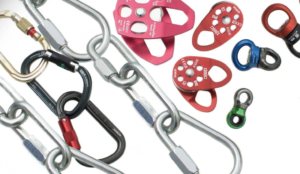Rigging safety: Please don’t hang from a tree (and other fun facts)
Have you ever wondered what’s keeping you safe while you’re hanging upside down 10 feet off the ground? Or perhaps you’ve visited other studios and been curious about an unfamiliar rigging system. The world of rigging is huge and filled with complex math, but we wanted to talk about a few things that every aerialist should know about what’s holding them up.
Aerial artists, and more generally, humans, create what’s called a dynamic load. There are different types of dynamic loads, but in simple terms, this means that the load moves, therefore changing magnitude or direction. We humans are always moving around, so anytime you rig for a live load, you have to assume it will be dynamic at some point. In aerials, you might think a basic pose should only create a load of your body weight + the apparatus, but think of all the things you have to do to get there: all the tiny little shifts in weight while you get in position, the swinging if you don’t start perfectly centered under your point, and the climbing if you‘re doing the pose off the ground.
When you add bigger skills and transitions, you can begin to generate multiple times your body weight, AND you can do it at unpredictable angles for the rig point. (Here’s a cool video showing how much force you can generate doing a variety of drops!) Therefore, our rig point has to be strong enough and stable enough to support all of that potential weight at all of those potential angles – plus you always want to add a buffer for safety and so you know it can support those forces repeatedly over time (as opposed to being able to support it once and then breaking the next time, similar to the way you’re supposed to replace your helmet after one impact). The generally accepted figure for this is in the 2,000lb to 5,000lb range depending on your intended use (drops, doubles, etc.), which is approximately the weight of a car! This means that if you wouldn’t hang a car from it, you shouldn’t do aerials off of it.
Another thing to remember is that if rigging fails, you’re not the only thing that’s going to come plummeting out of the sky. Even if you have catlike reflexes and always land safely on your feet, you also have to worry about everything else under the point of failure coming down on your head. Silks or a sling might not hurt too badly if the rigging hardware misses you, but have you ever been hit by a lyra or a trapeze bar? Worse yet, imagine if part of a ceiling (or a tree branch) comes down with it! Ouch.
Aside from the rigging point itself, your rigging hardware and apparatus also need to be appropriately rated. When we used the word “rated” here, we’re not talking about the number of stars something gets on Amazon – we’re talking about whether it has been scientifically, objectively tested to see if it’s strong enough to support the loads generated in aerials. (Here are some more cool videos showing how silks and carabiners are tested for strength!) Hardware such as carabiners and swivels are often marked with a rating in kilonewtons (kN), which are a measure of force (1 kN is roughly equivalent to 224.8lb). Of course, these ratings can be forged, so always buy your hardware from reputable brands and stores. Amazon is NOT a reputable provider, since their inventory practices intermingle items from different suppliers – so even if you ordered a reputable brand, you may get a counterfeit item instead.
So, what does this all mean when we’re looking up at a rig point and wondering if it’s safe? Well, your rigging is only as strong as its weakest link. Let’s assume you have your own appropriately rated hardware and apparatus. The other major factors to consider are the structure your rig point is attached to and HOW it’s attached – scotch tape isn’t going to cut it here.
With that in mind, here’s a partial list of things you probably wouldn’t hang a car from – and therefore should not do aerials on:
- TRX mounts: the mounts themselves aren’t usually well rated, but beyond that, they’re usually installed with dinky little screws, into ceilings that also aren’t rated. Most residential construction in the US isn’t built to be strong enough for aerials. (This might sound counterintuitive, but don’t forget your house has to hold up all its other contents in addition to supporting aerial activities – this includes people, furniture, appliances, and sometimes even snow on the roof.)
- Doorway pull-up bars: these might be ok for pull-ups, but please never invert on one! They’re usually either tension mounted or braced against the doorframe. Do you think that doorframe is strong enough to hold even half a car? Do you want to find out the answer is no while you’re hanging upside down from it?
- Trees: trees are our friends – please don’t hurt them! More practically: it’s really hard to tell if a tree is healthy unless you’re an arborist, and it’s easy to damage the tree even if it started out healthy. Also, here’s an article about sudden branch drop syndrome, but spoiler alert: it’s exactly what it sounds like!*
- Balcony railings: balcony railings might be strong enough to lean on, but they’re definitely not strong enough to rig from, especially because rigging from them often involves weird angles that they’re not designed for. They’re also often exposed to the elements, so you don’t know how much wear and tear they’ve seen.
- Swingsets: this is an interesting one – they are often rated, but only for children, and only for swinging. The way the swings are mounted usually disperses weight across the length of the beam in a particular way as well, which is very different than hanging a fabric or a lyra from one single point and then generating immense forces on it.
Lastly, if you’re ever in doubt about a rigging situation, you should always ask. If you’re visiting a new studio, ask them about their rigging points. If they can’t answer your questions confidently, consider going elsewhere. We know how tempting it can be to get your aerial fix, but your safety is more important!
* There actually are safe ways to rig from trees, but you need an arborist to inspect it EVERY time you plan to use it, plus a qualified rigger to install rigging that’s safe for both you AND the tree – it’s not as simple as tossing a spanset over a thick branch; it usually involves multiple anchor points and reinforcements.
-Sophia Chen

